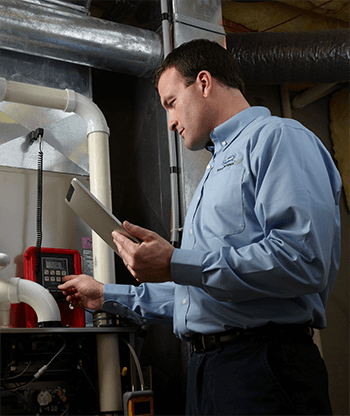
Heat is dispersed via your home in a variety of methods. Forced-air systems use ducts that can also be used for air conditioning and also heat pump systems. Radiant heat systems additionally have one-of-a-kind warmth distribution systems. That leaves 2 warmth distribution systems-- steam radiators and warm water radiators.
Steam Radiators
Heavy steam heating is just one of the oldest home heating modern technologies, yet the process of steaming and also condensing water is naturally much less reliable than more contemporary systems, plus it generally suffers from significant lag times in between the boiler turning on and the warmth getting here in the radiators. Consequently, heavy steam systems make it tough to carry out control strategies such as an evening problem system.
The initial main heater for structures used steam circulation because steam actions itself with piping without using pumps. Non-insulated steam pipes usually deliver unwanted heat to incomplete locations, making fiberglass pipeline insulation-- which can hold up against heats-- extremely economical.
Normal maintenance for heavy steam radiators depends on whether the radiator is a one-pipe system (the pipeline that supplies steam likewise returns condensate) or a two-pipe system (a separate pipeline returns condensate). One-pipe systems utilize automatic air vents on each radiator, which hemorrhage air as steam loads the system and then shut automatically when vapor gets to the vent. A stopped up air vent will certainly keep a heavy steam radiator from heating up. An air vent stuck open allows vapor to continually get away to the space, increasing family member humidity and also squandering gas. Air vents can sometimes be cleaned by steaming them in a water and vinegar service, however generally need to be replaced.
Heavy steam radiators can also warp the floor they are sitting on as well as their thermal development and also tightening in time can dig ruts into the flooring. Both of these impacts can trigger the radiator to turn, preventing water from properly draining from the radiator when it cools down. This will cause banging sounds when the radiator is warming up. Shims ought to be placed under radiators to pitch them somewhat towards the pipe in a one-pipe system or toward the heavy steam catch in a two-pipe system.
In https://furnace-repair-vaughan.com two-pipe systems, older heavy steam catches commonly embed either the open or shut position, shaking off the equilibrium in the system. If you seem to have problems with some radiators supplying excessive warm as well as others offering too little, this may be the cause. The most effective approach is often to merely change all the heavy steam traps in the system.
Vapor radiators found on outside wall surfaces can trigger warm loss by emitting warm via the wall surface to the outdoors. To prevent such warmth loss, you can install warm reflectors behind these radiators. You can make your very own reflector from foil-covered cardboard, offered from lots of building supply stores, or by installing foil onto a foam board or various other comparable shielding surface. The foil should face away from the wall surface, as well as the reflector needs to be the same size or somewhat larger than the radiator. Regularly tidy the reflectors to maintain optimal warm representation.
Hot Water Radiators
Hot-water radiators are just one of one of the most common warm distribution systems in more recent homes, second just to forced-air systems. They are generally a baseboard-type radiator or an upright layout that appears like steam radiators. One of the most usual trouble in hot-water systems is unwanted air in the system. At the start of each heating period, while the system is running, go from radiator to radiator and also open each bleed valve slightly, then shut it when water begins to escape via the shutoff. For multi-level residences, begin on top flooring and function your method down.
One means to conserve energy in hot-water systems is to retrofit them to provide separate zone control for different areas of big homes. Area control is most reliable when huge locations of the house are not used often or are used on a various timetable than other parts of the home. A home heating specialist can mount automated shutoffs on the hot-water radiators, managed by thermostats in each zone of the house. Utilizing programmable thermostats will certainly allow you to automatically heat up and cool off parts of your residence to match your usage patterns.
Area control works ideal in residences made to operate in various home heating areas, with each zone protected from the others. In houses not designed for zone control, leaving one area at a reduced temperature might trigger comfort problems in surrounding areas because they will certainly lose heat to the cooler parts of the residence. Area control will certainly also work best when the cooler areas of the residence can be isolated from the others by shutting doors. In many cases, new doors may be needed to separate one area from one more. Cooler parts of the home need to be maintained around 50 ° F to avoid pipes from cold. Never ever shut down heat totally in an extra part of your home.